How East Lake Clinic is expanding Trauma-Informed Care, starting with healing moments for our team
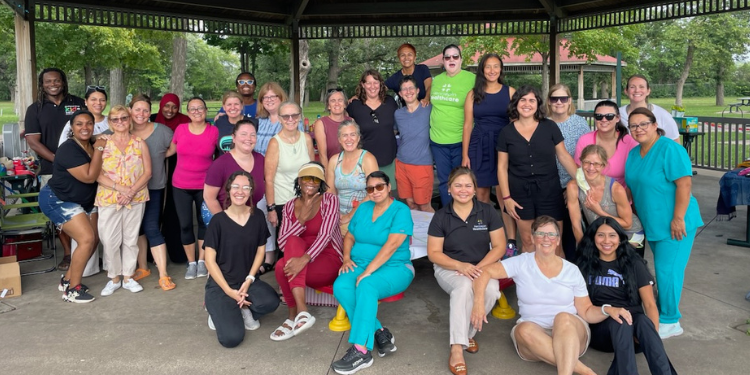
At an East Lake Clinic morning huddle in December, the team reviews staffing, supplies, recognition, and thanks before departing from the typical huddle format. Today, the team is asked to type a word or two on what symbolizes healing for them into a site that will create a word cloud of their responses. “Spiritual well-being” and “being healthy again” have already popped up on the word cloud as people grab their phones and start entering words that mean “healing” for them.
Trauma Healing Program Coordinator Margit Herrmann explains how the exercise connects to patient care: “We can think about maybe doing that with patients too and seeing what would go in the waiting room—actual physical items or pictures so when you enter the clinic and waiting room, you can see, ‘my culture or my family is represented here and we accept all these different kinds of healing.’”
When Hennepin Healthcare’s East Lake Clinic burned down in 2020 after the murder of George Floyd, for a while it was a clinic without a physical home. When the clinic was reopened in 2021, it was with a renewed purpose—to rebuild and repair the trauma of a hurting community (the internal staff community as well as the surrounding community from which our patients come). Over the last two and a half years, the clinic has brought team members, patients, and community partners together to create a roadmap for trauma-informed care. Generous funding from a Bush Foundation grant and Hennepin County has made this work possible.
The goal of transforming care
East Lake Clinic’s stated vision is to “transform the clinic into a place for trauma healing for staff and patients—transforming the health of our community by transforming the health of our clinic”.
“At times it can be a heady exercise, trying to wrap my head around the sheer number of individuals from all walks of life and ethnicities who come to East Lake Clinic with current and past traumas poorly affecting their mental and physical health,” says Dr. Ndidiamaka Koka in a reflection she wrote about the clinic’s transformation. “From the opening of the ELC clinic in 2021, the process of affecting a change in culture and care of the patients that walked through our clinic door has been under transformation.”
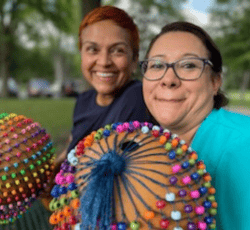
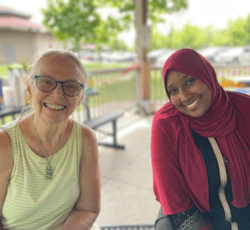
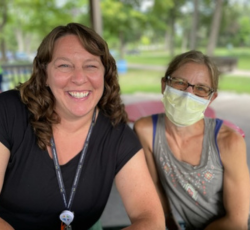
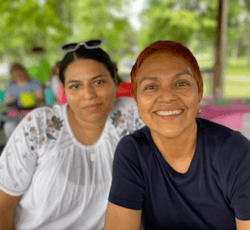
Healing trauma, starting with our team
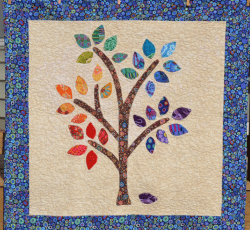 Trauma-informed care shifts our perspective from “What is wrong with you?” to “What has happened to you?”—prompting us to see the full context of a person’s behavior and what might have led to it, making us more compassionate and able to see people’s strengths. This means trauma-informed care has to start with our team relieving their stress and focusing on their healing so they can provide the best care to our patients.
Trauma-informed care shifts our perspective from “What is wrong with you?” to “What has happened to you?”—prompting us to see the full context of a person’s behavior and what might have led to it, making us more compassionate and able to see people’s strengths. This means trauma-informed care has to start with our team relieving their stress and focusing on their healing so they can provide the best care to our patients.
Each day in their morning huddle, the East Lake Clinic pauses for a healing moment like the word cloud exercise. In November, the theme was gratitude. In one huddle, the team wrote words of kindness to themselves, to others, or their younger selves. In January, the team is following a mindfulness theme. They do one-minute meditations and practice exercises that help with emotional regulation, like the RAIN exercise.
Clinic Practice Manager Ashley Turner says the culture at East Lake Clinic is different and shows up in small ways – like Dr. Koka beginning provider meetings with a quick check-in on how team members are doing and a breathing exercise. “Really being intentional about setting that time and that space for staff to be able to share what they’re going through—maybe even seek support from other colleagues—is very helpful,” Ashley says.
Once a month, the team holds a 20-to-30-minute trauma-informed care training and discussion at a staff meeting, focusing on topics like how to respond to dysregulation and tools to use before, during or after stressful events. In August 2023, the entire team attended an all-clinic retreat around healing-centered engagement, art, and healing drums. One of the exercises was to take leaves of fabric and write down, “What value do I bring to work? What do I bring to our clinic?” Team members reported back that they felt an increased sense of belonging and a stronger connection to the goals of diversity and inclusion.
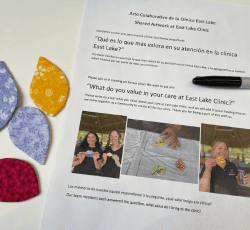 Community Health Worker Senior Cassandra Brouillette says, “We have come up with a lot of different tools of how to learn from each other, how to work with each other.” She says the team reflects on, “How do we hear each other and how do we show up for each other? How do we show up for patients?”
Community Health Worker Senior Cassandra Brouillette says, “We have come up with a lot of different tools of how to learn from each other, how to work with each other.” She says the team reflects on, “How do we hear each other and how do we show up for each other? How do we show up for patients?”
What our team has to say about the trauma healing retreat and huddle pauses
“The engagement, and openness to learn and participate and show gratitude towards others has been great!”
Huddle pauses “help us regroup and take a minute to breath and continue with our daily work in a positive manner.”
“Everyone knows that there is going to be a time for us to bond and take some time to reflect during huddles.”
Healing trauma, from the moment patients walk in the door
The clinic is also transforming its physical environment based on feedback they gathered directly from patients in community focus groups. There is a coffee cart in the waiting room and each member of the care team has a photo hung on the wall.
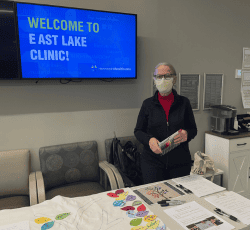 In December, the team replicated the exercise they did with the team and asked patients in the waiting room, “What is most important to you in your care at East Lake, or what do you value the most in your care at East Lake Clinic?” As they waited for appointments, patients wrote words on brightly colored tree leaves made from fabric—Love, Be Patient, Feeling Heard, Empatia (empathy), Honestidad (honesty), Amabilidad (friendliness), Positive, Grief Relief. The team wasn’t sure that patients would want to join a waiting room activity, but the patients filled up every leaf. The leaves will eventually become a quilt that represents both the team’s and the patients’ hopes for care at the clinic.
In December, the team replicated the exercise they did with the team and asked patients in the waiting room, “What is most important to you in your care at East Lake, or what do you value the most in your care at East Lake Clinic?” As they waited for appointments, patients wrote words on brightly colored tree leaves made from fabric—Love, Be Patient, Feeling Heard, Empatia (empathy), Honestidad (honesty), Amabilidad (friendliness), Positive, Grief Relief. The team wasn’t sure that patients would want to join a waiting room activity, but the patients filled up every leaf. The leaves will eventually become a quilt that represents both the team’s and the patients’ hopes for care at the clinic.
“I think over the last few months and years, people can see that everyone has gone through experiences, and everyone has gone through trauma—no matter, the patient, a team member or in the community,” Margit says. “How can we better respond? Yes, a big part of that is to treat our patients in the best way possible, but also, we need to take care of ourselves to be able to do that.”
“If we don’t focus on the wellness of our staff, nothing else will move forward,” said Physician Maria Kaefer. “Trauma-informed care will just be an external idea – like this is something we do for other people and not for us.”

